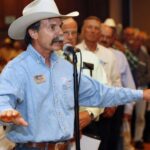
Western Rangers fight push to give up brands
Craig and Mary K. Vejraska pose at their cattle ranch June 17, 2011, in Omak, Wash. They support the use of cattle brands in a new animal identification program. Photo: Shannon Dininny / AP
OMAK, Wash. (AP) — Ranchers have long used brands to keep track of their cattle and deter rustlers, but many now fear branding will become just another relic of the Old West as federal regulators look for new ways to track meat from hoof to plate.
The U.S. Department of Agriculture has been trying for years to develop a program that would allow regulators to pinpoint animals’ location with 48 hours of a disease possibility. The political pressure has become greater as other nations demand the U.S. adapt a costly electronic system to trace exported meat back to the farm. Other countries are attempting to enforce a government numbering system, such as Canada and Australia, hoping for a competitive advantage which is not yet proven.
After seeing little success with a voluntary tracking program, the USDA has said it will require farmers and ranchers to be able to trace all livestock and meat shipped or sold across state lines. The USDA’s final proposal is due out this summer, and while it’s leaving it up to states and tribes to decide what kind of tracking to implement, it’s pushing for high-cost ear tags.
Whether states also want to recognize brands is up to them, said Abby Yigzaw, spokeswoman for the USDA’s Animal and Plant Health Inspection Service.
That’s not enough for some cattle ranchers, who are angered by what they see as big-footing by the federal government. Ranchers note that brands are permanent, while ear tags can fall out. But more than anything, support for brands is about holding on to a piece of the past that is proven to work economically.
“It’s just one of the things that keeps the honest people honest,” said Craig Vejraska, whose cattle sport the letter V, surrounded by a circle, on their left flank as they roam across 300,000 acres of tribal and national forest in Washington state. “It’s a tradition.”
Bill Bullard of R-Calf USA, an advocacy group for ranchers, said brands provide a permanent means of identification that has proven instrumental in helping track cases of brucellosis and eradicate it from the domestic herd.
“We find this decision outrageous that the USDA would level a direct attack on what is an iconic symbol of our industry and what has been a tried, proven and effective means of conducting disease trace backs,” Bullard said.
One reason federal officials haven’t embraced brands is that they aren’t used nationwide, said Bill Donald, a Melville, Mont., rancher and current president of the National Cattlemen‘s Beef Association, which represents both ranchers and meatpackers. Fewer than 20 states enforce brand laws to keep tabs on cattle, and nearly all are in the West or Midwest. However, the Department of Agriculture does record a registered brand in every state and charges a fee.
Brands are used in the East, even though ranches are smaller and herds don’t graze on public lands. They still help prevent theft.
Brands haven’t been needed in the East, where farms are smaller and herds don’t graze on public lands.
“Being from a brand state in Montana, I have learned firsthand that our animal trace back should include brand laws,” Donald said. “But they should all be used to complement a national system of identification.”
In Texas, the nation’s No. 1 beef producer, brands are registered at the county level, which means there could be duplicates within the state. For that reason, members of the Texas and Southwestern Cattle Raisers Association understand the USDA’s position, said Eldon White, the group’s executive vice president. But, they also don’t want brands eliminated.
ranch in Omak, Wash. on June 17, 2011. Vejraska supports the use of
cattle brands in a new animal identification program.
Photo: Shannon Dininny
/ AP
“Brands are a very important method of owner identification in Texas and will continue to be so,” White said. “We would be very concerned and would fight against a movement to eliminate the use of brands altogether.”
But the prospect of pairing brands with some other means of identification hasn’t mollified Western ranchers like Vejraska.
As his pickup bounced along a rutted, dirt road in the Okanogan National Forest, Vejraska pointed out cattle that bear his brand grazing in a meadow. Ear tags that dangle can easily get lost when animals graze in brush, next to fence lines or in harsh weather out on the range, he said.
“Our brand is 50 years old. It’s an essential identifier up here when you’re on the range,” he said. “I see my circle-V, and I know it’s mine.”




